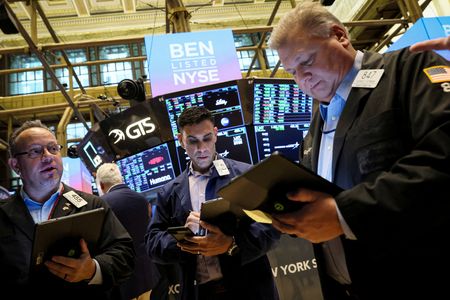A look at the day ahead in U.S. and global markets from Mike Dolan
Even if investors sense light at the end of the tunnel, Western central banks are clearly not finished tightening credit just yet – certainly not in ‘inflation outlier’ Britain.
Federal Reserve chair Jerome Powell threw more cold water on hopes for any reversal of the Fed’s interest rate rise campaign on Wednesday and kept pointing to another two hikes even as markets still assume one final quarter point move next month.
If the economy performs as now expected, two more rate rises is a ‘pretty good guess’ of what happens next, Powell told the House Financial Services Committee on Tuesday. He reprises the testimony to the Senate later today.
Markets have been here before over the past year – continually underestimating the economy’s resilience and Fed’s trajectory.
But while futures markets still don’t quite believe the ‘two more’ signal, the Fed has had some success in talking them back from assuming any significant easing from there over the remainder of the year at least. Right now, pricing suggests a July hike will not be fully reversed until March.
And this view seems to tally better with the more dovish view from one of Powell’s colleagues.
“My baseline is that we should stay at this level for the rest of the year” and not cut rates until late 2024, Atlanta Fed chief Raphael Bostic said in an interview on Yahoo Finance.
There was far less ambiguity in moves from Europe’s central banks on Thursday.
Following Wednesday’s shock news of an acceleration in UK ‘core’ inflation last month to 31-year highs, the Bank of England is set on Thursday to deliver another quarter-point rate rise to 4.75% – its 13th rate hike in a campaign than started in 2021.
Markets think there’s a 50-50 chance of a harsher 50 basis point move and now see the peak BoE ‘terminal’ rate as high as 6% – some 150bp higher than here.
The Swiss National Bank raised rates by 25bp earlier, as expected, but also left the door open for more tightening.
And Norway’s central bank surprised with an aggressive 50bp rise to a 15-year high of 3.75% and signaled another move in August.
In the emerging market world, Turkey was expected to more than double its 8.5% interest rate in a post-election macroeconomic policy reset.
All the hawkishness has blown some of the froth of this month’s stock market enthusiasm.
European bourses were down about 1% and U.S. stock futures were in the red again on Thursday, pointing to a fourth consecutive daily drop in the S&P500. Two-year U.S. Treasury yields were a fraction higher but the dollar touched its lowest in more than a month.
U.S. weekly jobless numbers, which have been rising in recent weeks, will be watched closely for further signs of a loosening of the tight U.S. labor market.
But in a sign that renewed faith in the bull market hasn’t been damaged yet, Wall St’s VIX ‘fear index’ of implied equity volatility registered its lowest close on Wednesday since January 2020.
In corporate news, Britain’s Ocado soared 17.4% to the top of the STOXX 600 after The Times reported talk of possible bid interest in the company.
Events to watch for later on Thursday:
* Bank of England policy decision; Turkey and Mexico central bank policy decisions
* U.S. weekly jobless claims, U.S. May existing home sales, Kansas City Federal Reserve June business survey, Chicago Fed May economic activity index, U.S. Q1 current account
* Federal Reserve Chair Jerome Powell delivers semi-annual testimony to Senate Banking Committee
* Fed Board Governors Christopher Waller and Michelle Bowman speak; Cleveland Fed chief Loretta Mester and Richmond Fed chief Thomas Barkin speak
* U.S. Treasury auctions 5-year inflation-protected securities, 4-week bills
* U.S. Corporate earnings: Carmax, Accenture, Darden Restaurants
(By Mike Dolan, editing by Elaine Hardcastle, [email protected]. Twitter: @reutersMikeD)





